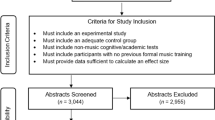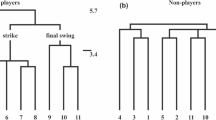Abstract
The purpose of this study was to evaluate the effects of video modeling on the performance of fine and gross motor skills comprising multi-step tasks. Six home living tasks, which included both fine and gross motor skills, were included in the study and were completed by four adults with moderate intellectual disability. A multiple probe design across behaviors was used to assess performance across three sets of skills with four participants. Results showed there were minimal differences between performances on the two types of skills; however, individual differences did occur and overall the participants performed a greater percentage of fine motor skills independently correct. Implications are presented for considering not only the motor requirements of tasks presented through video models, but also the cognitive and visual processing demands of tasks.




Similar content being viewed by others
References
Ayres, K. M., & Gast, D. L. (2010). Dependent measures and measurement procedures. In D. L. Gast (Ed.), Single subject research methodology in behavioral sciences (pp. 329–381). New York: Routledge Publishers.
Ayres, K. M., & Langone, J. (2005). Intervention and instruction with video for students with autism: A review of the literature. Education and Training in Developmental Disabilities, 40, 183–196.
Ayres, K. M., & Langone, J. (2007). A comparison of video modeling perspectives for students with autism. Journal of Special Education Technology, 22(2), 15–30.
Bellini, S., & Akullian, J. (2007). A meta-analysis of video self-modeling interventions for children and adolescents with autism spectrum disorders. Exceptional Children, 73, 264–287.
Biederman, G. B., Stepaniuk, S., Davey, V. A., Raven, K., & Ahn, D. (1999). Observational learning in children with down syndrome and developmental delays: The effect of presentation speed in videotaped modeling. Down Syndrome Research and Practice, 6(1), 12–18.
Cannella-Malone, H., Sigafoos, J., O’Reilly, M., De La Cruz, B., Edrisinha, C., & Lancioni, G. E. (2006). Comparing video prompting to video modeling for teaching daily livings skills to six adults with developmental disabilities. Education and Training in Developmental Disabilities, 41, 344–356.
Cannella-Malone, H. I. et al. (2010). Teaching daily living skills to seven individuals with severe intellectual disabilities: A comparison of video prompting to video modeling. Journal of Positive Behavior Intervention. doi:10.1177/1098300710366593.
Cihak, D. F., & Schrader, L. (2008). Does the model matter? Comparing video self-modeling and video adult modeling for task acquisition and maintenance by adolescents with autism spectrum disorders. Journal of Special Education Technology, 23(3), 9–20.
Comprehensive Adult Student Assessment Systems (2002). www.casa.org
Delano, M. (2007). Video modeling interventions for individuals with autism. Remedial and Special Education, 28, 33–42.
Gast, D. L. (2010). Single subject research methodology in behavioral sciences (329–381). New York: Routledge Publishers.
McCoy, K., & Hermansen, E. (2007). Video modeling for individuals with autism: A review of model types and effects. Education and Treatment of Children, 30, 183–213.
Mechling, L. C. (2005). The effect of instructor-created video programs to teach students with disabilities: A literature review. Journal of Special Education Technology, 2(2), 25–36.
Mechling, L. C., & Ayres, K. M. (2012). A comparative study: Completion of fine motor office related tasks by high school students with autism using video models on large and small screen sizes. Journal of Autism and Developmental Disabilities. doi:10.1077/s10803-012-1484-1.
Mechling, L. C., Collins, T. S. (2012). Comparison of the effects of video models with and without verbal cuing on task completion by young adults with moderate intellectual disabilities. Education and Training in Autism and Developmental Disabilities.
Mechling, L. C., & Swindle, C. O. (2012). Fine and gross motor task performance when using computer-based video models by students with autism and moderate intellectual disabilities. Journal of Special Education. doi:0022466911433859.
Mechling, L. C., & Youhouse, I. R. (2012). Comparison of task performance by students with autism and moderate intellectual disabilities when presenting video models on large and small screen sizes. Journal of Special Education Technology, 47, 223–235.
Rayner, C., Denholm, C., & Sigafoos, J. (2009). Video-based intervention for individuals with autism: Key questions that remain unanswered. Research in Autism Spectrum Disorders, 3, 291–303.
Shukla-Mehta, S., Miller, T., & Callahan, K. J. (2010). Evaluating the effectiveness of video instruction on social and communication skills training for children with autism spectrum disorders: A review of the literature. Focus on Autism and Other Developmental Disabilities, 25, 23–36.
Sparrow, S. S., Balla, D. A., & Cicchetti, D. V. (1984). Vineland adaptive behavior scales. Circle Pines, MN: American Guidance Service.
Taber-Doughty, T., Patton, S. E., & Brennan, S. (2008). Simultaneous and delayed video modeling: An examination of system effectiveness and student preferences. Journal of Special Education Technology, 23(1), 1–18.
Thorndike, R. L., Hagan, E. P., & Sattler, J. M. (1986). Stanford-Binet intelligence scale. Itasca, IL: Riverside Publishing.
Van Laarhoven, T., Zurita, L. M., Johnson, J. W., Grider, K. M., & Grider, K. L. (2009). Comparison of self, other, and subjective video models for teaching daily living skills to individuals with developmental disabilities. Education and Training in Developmental Disabilities, 44, 509–522.
Wechsler, D. (1977). Wechsler Adult Intelligence Scale-III. San Antonio, TX: Psychological Corp.
Author information
Authors and Affiliations
Corresponding author
Rights and permissions
About this article
Cite this article
Mechling, L., Ayres, K.M., Purrazzella, K. et al. Evaluation of the Performance of Fine and Gross Motor Skills within Multi-Step Tasks by Adults with Moderate Intellectual Disability when Using Video Models. J Dev Phys Disabil 24, 469–486 (2012). https://doi.org/10.1007/s10882-012-9284-2
Published:
Issue Date:
DOI: https://doi.org/10.1007/s10882-012-9284-2




